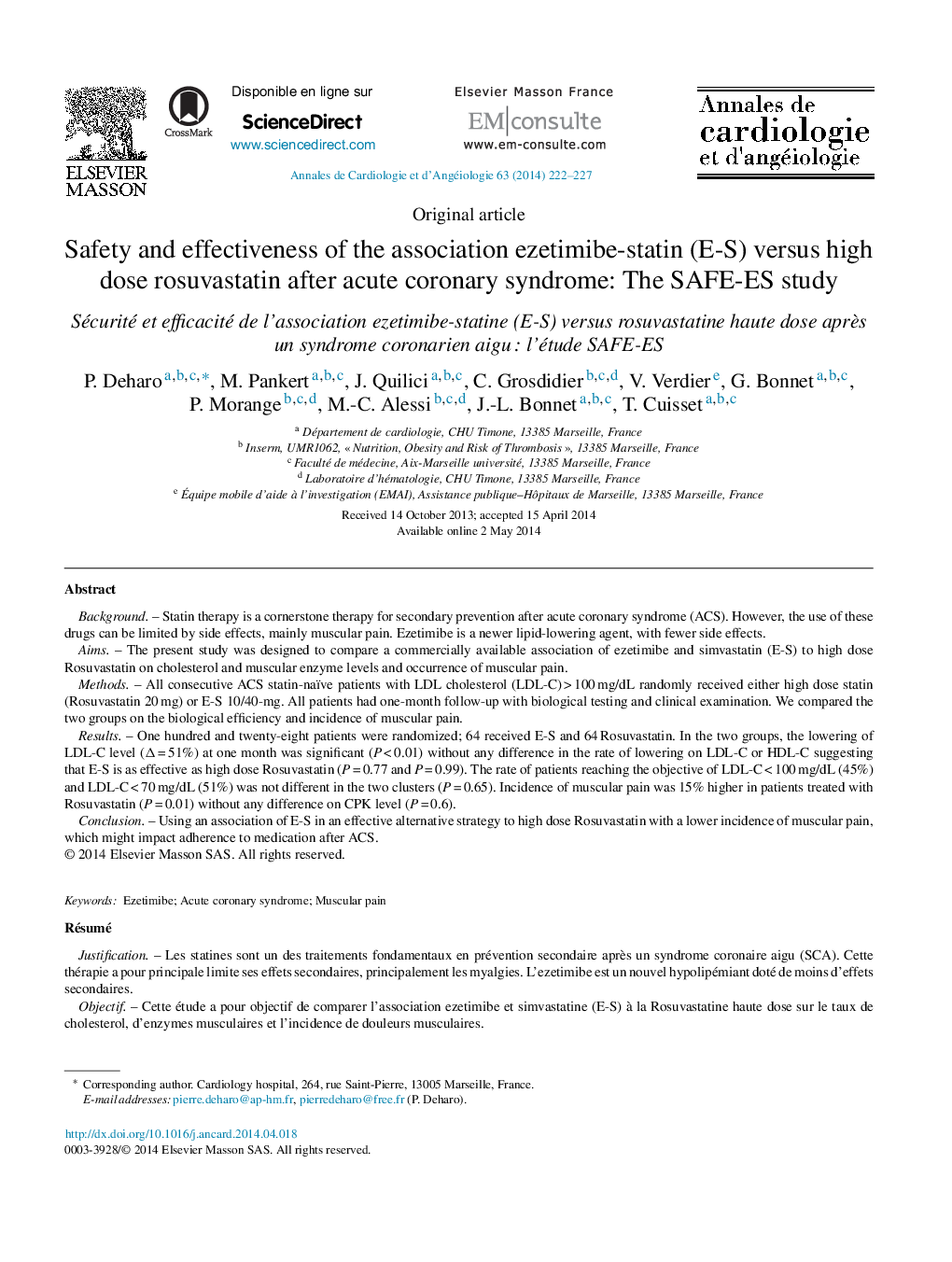| Article ID | Journal | Published Year | Pages | File Type |
|---|---|---|---|---|
| 2868735 | Annales de Cardiologie et d'Angéiologie | 2014 | 6 Pages |
BackgroundStatin therapy is a cornerstone therapy for secondary prevention after acute coronary syndrome (ACS). However, the use of these drugs can be limited by side effects, mainly muscular pain. Ezetimibe is a newer lipid-lowering agent, with fewer side effects.AimsThe present study was designed to compare a commercially available association of ezetimibe and simvastatin (E-S) to high dose Rosuvastatin on cholesterol and muscular enzyme levels and occurrence of muscular pain.MethodsAll consecutive ACS statin-naïve patients with LDL cholesterol (LDL-C) > 100 mg/dL randomly received either high dose statin (Rosuvastatin 20 mg) or E-S 10/40-mg. All patients had one-month follow-up with biological testing and clinical examination. We compared the two groups on the biological efficiency and incidence of muscular pain.ResultsOne hundred and twenty-eight patients were randomized; 64 received E-S and 64 Rosuvastatin. In the two groups, the lowering of LDL-C level (Δ = 51%) at one month was significant (P < 0.01) without any difference in the rate of lowering on LDL-C or HDL-C suggesting that E-S is as effective as high dose Rosuvastatin (P = 0.77 and P = 0.99). The rate of patients reaching the objective of LDL-C < 100 mg/dL (45%) and LDL-C < 70 mg/dL (51%) was not different in the two clusters (P = 0.65). Incidence of muscular pain was 15% higher in patients treated with Rosuvastatin (P = 0.01) without any difference on CPK level (P = 0.6).ConclusionUsing an association of E-S in an effective alternative strategy to high dose Rosuvastatin with a lower incidence of muscular pain, which might impact adherence to medication after ACS.
RésuméJustificationLes statines sont un des traitements fondamentaux en prévention secondaire après un syndrome coronaire aigu (SCA). Cette thérapie a pour principale limite ses effets secondaires, principalement les myalgies. L’ezetimibe est un nouvel hypolipémiant doté de moins d’effets secondaires.ObjectifCette étude a pour objectif de comparer l’association ezetimibe et simvastatine (E-S) à la Rosuvastatine haute dose sur le taux de cholesterol, d’enzymes musculaires et l’incidence de douleurs musculaires.MéthodeLes patients admis dans notre centre pour SCA avec LDL-C > 100 mg/dL ont été randomisés en deux groupes, Rosuvastatine 20 mg ou E-S 10/40-mg. Les patients ont été revus à un mois avec examens cliniques et biologiques. L’efficacité biologique et l’incidence des douleurs musculaires ont été comparées entre les groupes.RésultatsCent vingt-huit patients ont été randomisés ; 64 recevant E-S et 64 la Rosuvastatine. Dans les deux groupes, la baisse du taux de LDL-C (Δ = 51 %) à un mois a été significative (p < 0,01) sans différence dans le taux de variation entre les deux groupes sur LDL-C et HDL-C (p = 0,77 and p = 0,99), suggérant que E-S est aussi efficace que la Rosuvastatine. Le taux de patients atteignant les objectifs de LDL-C < 100 mg/dL (45 %) et LDL-C < 70 mg/dL (51 %) n’était pas différent entre les deux groupes (p = 0,65). L’incidence des douleurs musculaires était de 15 % supérieure chez les patients sous Rosuvastatine (p = 0,01), sans difference sur le taux de CPK (p = 0,6).ConclusionL’association E-S est une stratégie efficace, constituant une alternative à la Rosuvastatine avec une faible incidence de douleurs musculaires induites qui peuvent influencer l’adhérence au traitement.
